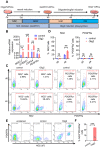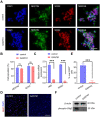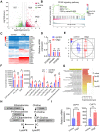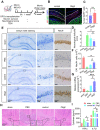Shh and Olig2 sequentially regulate oligodendrocyte differentiation from hiPSCs for the treatment of ischemic stroke
- PMID: 35547747
- PMCID: PMC9065175
- DOI: 10.7150/thno.69217
Shh and Olig2 sequentially regulate oligodendrocyte differentiation from hiPSCs for the treatment of ischemic stroke
Abstract
Rationale: Demyelination is a major component of white matter injury, characterized by oligodendrocyte (OL) death and myelin sheath loss, which result in memory loss and cognitive impairment in the context of ischemic stroke. Accumulating evidence has shown that OLs can be generated by the direct activation of defined transcription factors (TFs) in human induced pluripotent stem cells (hiPSCs); however, the rapid acquisition of single TF-induced OL progenitor cells (OPCs) as cell therapy for ischemic stroke remains to be thoroughly explored. Methods: A stable, chemically defined protocol was used to generate a substantial number of transplantable and functional OLs through the partial inhibition of sonic hedgehog (Shh) activity by GANT61 during neural induction from hiPSCs and sequential induction of TF Olig2 overexpression. Transcriptome and metabolome analyses further revealed a novel molecular event in which Olig2 regulates OL differentiation from hiPSC-derived neural progenitor cells (NPCs). Olig2-induced NG2+ OPCs (Olig2-OPCs) were then evaluated for their therapeutic potential in cell-based therapy for ischemic stroke. Results: GANT61 treatment resulted in a motor neuron (MN)-OL fate switch during neural induction, and induced overexpression of Olig2 accelerated oligodendroglial lineage cell specification. Olig2-OPCs expressed typical oligodendroglial lineage marker genes, including NKX2.2, CSPG4, and ST8SIA1, and displayed superior ability to differentiate into mature OLs in vitro. Mechanistically, Olig2-OPCs showed increased gene expression of the peroxisome proliferator-activated receptor γ (PPARγ) signaling pathway, and activated CEPT1-mediated phospholipogenesis. Functionally, inhibiting PPARγ and knocking down CEPT1 further compromised the terminal differentiation of Olig2-OPCs. Most importantly, when transplanted into a rat model of transient middle cerebral artery occlusion (tMCAO), Olig2-OPCs efficiently promoted neurological functional recovery by reducing neuronal death, promoting remyelination, and rescuing spatial memory decline. Conclusions: We developed a stable, chemically defined protocol to generate OPCs/OLs with partial inhibition of Shh activity by GANT61 from hiPSCs and sequentially induced the expression of the single TF Olig2. Olig2-OPC transplantation may be an ideal alternative approach for ischemic stroke rehabilitation therapy.
Keywords: Human induced pluripotent stem cells (hiPSCs); Ischemic stroke.; Olig2; Oligodendrocyte progenitor cells (OPCs); Sonic hedgehog (Shh).
© The author(s).
Conflict of interest statement
Competing Interests: The authors have declared that no competing interest exists.
Figures







Similar articles
-
Rapid differentiation of hiPSCs into functional oligodendrocytes using an OLIG2 synthetic modified messenger RNA.Commun Biol. 2022 Oct 14;5(1):1095. doi: 10.1038/s42003-022-04043-y. Commun Biol. 2022. PMID: 36241911 Free PMC article.
-
Temporal and partial inhibition of GLI1 in neural stem cells (NSCs) results in the early maturation of NSC derived oligodendrocytes in vitro.Stem Cell Res Ther. 2019 Aug 27;10(1):272. doi: 10.1186/s13287-019-1374-y. Stem Cell Res Ther. 2019. PMID: 31455382 Free PMC article.
-
Oligodendrocyte progenitor cell-specific delivery of lipid nanoparticles loaded with Olig2 synthetically modified messenger RNA for ischemic stroke therapy.Acta Biomater. 2024 Jan 15;174:297-313. doi: 10.1016/j.actbio.2023.12.009. Epub 2023 Dec 13. Acta Biomater. 2024. PMID: 38096960
-
Oligodendrocyte progenitor programming and reprogramming: Toward myelin regeneration.Brain Res. 2016 May 1;1638(Pt B):209-220. doi: 10.1016/j.brainres.2015.10.051. Epub 2015 Nov 4. Brain Res. 2016. PMID: 26546966 Free PMC article. Review.
-
Engineering biomaterial microenvironments to promote myelination in the central nervous system.Brain Res Bull. 2019 Oct;152:159-174. doi: 10.1016/j.brainresbull.2019.07.013. Epub 2019 Jul 12. Brain Res Bull. 2019. PMID: 31306690 Review.
Cited by
-
Rapid differentiation of hiPSCs into functional oligodendrocytes using an OLIG2 synthetic modified messenger RNA.Commun Biol. 2022 Oct 14;5(1):1095. doi: 10.1038/s42003-022-04043-y. Commun Biol. 2022. PMID: 36241911 Free PMC article.
-
Ursolic Acid Ameliorated Neuronal Damage by Restoring Microglia-Activated MMP/TIMP Imbalance in vitro.Drug Des Devel Ther. 2023 Aug 22;17:2481-2493. doi: 10.2147/DDDT.S411408. eCollection 2023. Drug Des Devel Ther. 2023. PMID: 37637267 Free PMC article.
-
Mechanistic insights of neuronal death and neuroprotective therapeutic approaches in stroke.Neural Regen Res. 2026 Mar 1;21(3):869-886. doi: 10.4103/NRR.NRR-D-24-01324. Epub 2025 Apr 29. Neural Regen Res. 2026. PMID: 40313116 Free PMC article.
-
Olig2 Ablation in Immature Oligodendrocytes Does Not Enhance CNS Myelination and Remyelination.J Neurosci. 2022 Nov 9;42(45):8542-8555. doi: 10.1523/JNEUROSCI.0237-22.2022. Epub 2022 Oct 5. J Neurosci. 2022. PMID: 36198499 Free PMC article.
-
Differentiation of peripheral sensory neurons from iPSCs derived from stem cells from human exfoliated deciduous teeth (SHED).Front Cell Dev Biol. 2023 Jul 13;11:1203503. doi: 10.3389/fcell.2023.1203503. eCollection 2023. Front Cell Dev Biol. 2023. PMID: 37519304 Free PMC article.
References
-
- Lo EH, Dalkara T, Moskowitz MA. Mechanisms, challenges and opportunities in stroke. Nat Rev Neurosci. 2003;4:399–415. - PubMed
-
- Domercq M, Perez-Samartin A, Aparicio D, Alberdi E, Pampliega O, Matute C. P2X7 receptors mediate ischemic damage to oligodendrocytes. Glia. 2010;58:730–40. - PubMed
-
- Nunn J, Hodges H. Cognitive deficits induced by global cerebral ischaemia: relationship to brain damage and reversal by transplants. Behav Brain Res. 1994;65:1–31. - PubMed
Publication types
MeSH terms
Substances
LinkOut - more resources
Full Text Sources
Medical
Miscellaneous

